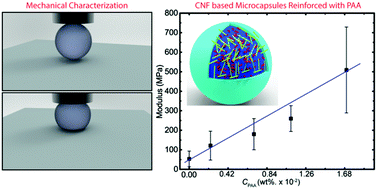
March 25, 2017
Gilad Kaufman and co-authors from the Osuji lab used light scattering to characterize the surface charge of cellulose nanofibers. In their work, they have shown that through electrostatic interactions and hydrogen bonding between cellulose nanofibrils and a conjugate species a shell can be formed around an emulsion droplet resulting in a core-shell construct- a microcapsule. This study, demonstrates that these microcapsules are mechanically robust and their mechanical properties can be tuned by the addition of a binder species. This work has been published in Soft Matter.
Highly stiff yet elastic microcapsules incorporating cellulose nanofibrils
Gilad Kaufman, Shomeek Mukhopadhyay, Yekaterina Rokhlenko, Siamak Nejati, Rostislav Boltyanskiy, Youngwoo Choo, Michael Loewenberg and Chinedum O. Osuji
Abstract:
Microcapsules with high mechanical stability and elasticity are desirable in a variety of contexts. We report a single-step method to fabricate such microcapsules by microfluidic interfacial complexation between high stiffness cellulose nanofibrils (CNF) and an oil-soluble cationic random copolymer. Single-capsule compression measurements reveal an elastic modulus of 53 MPa for the CNF-based capsule shell with complete recovery of deformation from strains as large as 19%. We demonstrate the ability to manipulate the shell modulus by the use of polyacrylic acid (PAA) as a binder material, and observe a direct relationship between the shell modulus and the PAA concentration, with moduli as large as 0.5 GPa attained. These results demonstrate that CNF incorporation provides a facile route for producing strong yet flexible microcapsule shells.